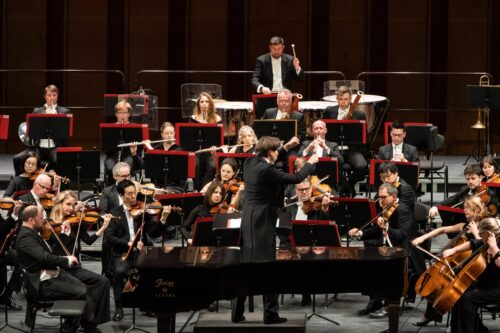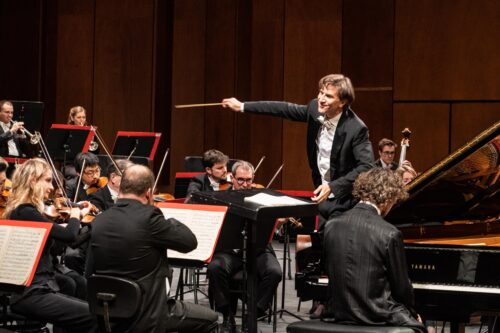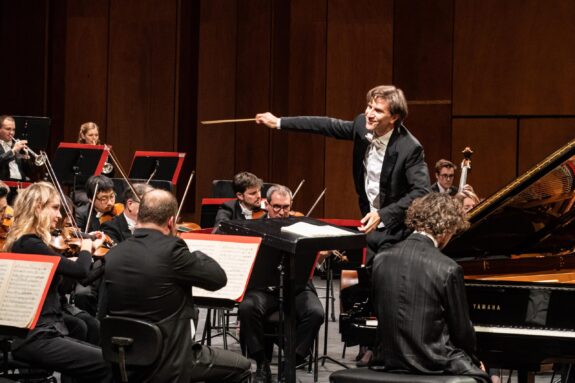 United Kingdom Beethoven, Mozart, Brahms: Martin Helmchen (piano); Philharmonia Orchestra / Alessandro Crudele (conductor). Teatro Petruzzelli Bari, Italy, 26.11.2024. (CC)
United Kingdom Beethoven, Mozart, Brahms: Martin Helmchen (piano); Philharmonia Orchestra / Alessandro Crudele (conductor). Teatro Petruzzelli Bari, Italy, 26.11.2024. (CC)

Beethoven – Fidelio – Overture, Op.72 (1814)
Mozart – Piano Concerto No.16 in D, K 451 (1784)
Brahms – Symphony No.4 in E minor, Op.98 (1885)
This was the first of two concerts in the Philharmonia’s tour of Puglia, Italy. The second was in Teatro Curci, Barletta, the second in honour of Carlo Maria Giulini (‘In onore di Carlo Maria Giulini’; Barletta is the city of Giulini’s birth).
The Bari programme might seem like a standard overture-concerto-symphony one, but it held real magic. The Mozart Piano Concerto was one of the lesser-known ones, No.16 in D, K 451, performed magically by Martin Helmchen; the Beethoven and Brahms emerged with an invigorating freshness of approach thanks to the direction of the Milanese conductor (of Apulian extraction) Alessandro Crudele.
Crudele has made a name for himself with two significant releases on the Linn label, one of Respighi (including the rarely heard Belkis, regna di Saba) and one of Britten (‘Sea Interludes’ from Peter Grimes) and Elgar (Violin Concerto with Michael Barenboim), both on the Linn label. Crudele’s fascination with conducting was bolstered by a chance meeting with Giulini while a teenager; later, he went to Berlin (where he now lives) to study with Sir Simon Rattle.
This exceptional pedigree is maximally realised in Crudele. I was lucky to hear some of the rehearsal in the lovely Teatro Petruzzelli: Crudele knows exactly what he wants and how to get it, and quickly. Rehearsal points are carefully targeted, spotlighting issues succinctly and exactly. He is concerned with detail but in the context of the overall structure, and as we shall see, this comes across in the final performances.
So to Beethoven’s Fidelio Overture, the pocket-rocket replacement for the Leonore overtures and heard in Vienna in 1814. The whole was distinguished by a sense of urgency and singleness of purpose. The harmonic awareness here was particularly notable, meaning that tension was built inexorably. Quite right, too, that the second horn was singled out after the performance for applause: Kira Doherty has repeatedly proved herself as a fine player over the course of many London concerts, and she excelled here. Any errors in ensemble overall were minor in comparison to the convincing sweep to the account.
It was fascinating to hear Mozart’s Piano Concerto No.16 in D major: one of the rarer concertos in performance, this was indeed my first encounter with it in a concert hall. And Helmchen and Crudele’s account could hardly be bettered. Miraculously, despite a large string quotient, Crudele ensured lightness and transparency from the orchestra. The opening fizzed like a Mozart opera overture; woodwind excelled. Matching this sense of effortless lightness was Helmchen. This piano concerto was one of six composed in 1784, evidently a year of much compositional fluency for the composer, and the sense of the music just falling off Mozart’s pen was palpable. Mozart’s keyboard writing leaves the pianist with nowhere to hide, and Helmchen’s felicity of touch was superb (including a particularly even left-hand). Helmchen’s timbral variety is subtly deployed yet always effective; but most enchanting was the woodwind/piano dialogue.
The central Andante was a dream, an opera aria for piano. The deceptive simplicity of the piano writing brought forth a multitude of subtleties from Helmchen; harmonic turns to the minor were beautifully honoured by both piano and orchestra, and yet more of those woodwind/piano exchanges enchanted, now oriented towards a more interior world. Both Helmchen and Crudele found more varied terrain in this movement than is often the case, while the finale, an Allegro di molto, found the orchestra injecting beautiful, pointed accents within both piano and pianissimo. This closing movement is full of contrasts, all superb, as was, here, a fine flute/piano exchange. Helmchen provided a simply phenomenal cadenza, but what shone was the performance’s celebration of Mozart’s invention.

Helmchen played Mozart’s own cadenzas as if he was the one who was improvising. A Mozart Adagio as encore (the second movement of Piano Sonata No.12 in F, K 332 / 300k) was the perfect way to close the first half. Interestingly, Helmchen has recorded No.16’s neighbour, No.15, for Pentatone with the Netherlands Chamber Orchestra and Gordan Nikolić, a recording which reveals many of the same strengths heard in Bari.
And so to Brahms, the surely universally-loved Fourth Symphony. Cast in E minor, this symphony asks the question: how relaxed is this to be? Some performances offer a more objective view (try Ádám Fischer’s recent small-orchestra version with the Danish Chamber Orchestra on Naxos, for instance), some reveal a tendency towards indulgence (the later Karajan, although it is there in embryo in Lucerne, 1965), whilst some ride a middle path (try William Steinberg’s remarkable Pittsburgh performance, also from 1965). Crudele is of this last variety, creating a sense of unfolding that is nevertheless underpinned by a tension that allows for rubato without losing the underling pulse. Interesting, too, that Crudele created a definably warmer orchestral sound in the orchestra – quite rightly – than anything heard thus far. Here, woodwind and brass ensemble was brilliantly together. And talking of togetherness, rarely have I heard the unison horns at the opening of the Andante moderato as if just one instrument was playing, just with a different colour to that of a single horn (and surely this is exactly what Brahms intended). One should acknowledge a simply gorgeous cello moment, too, of the music blossoming: the cello section is one of the Philharmonia’s glories, and Crudele allowed them to shine. The tempo for the movement was quite slow, perhaps, but this only accorded it real gravitas.
The scherzo was an Allegro giocoso that blazed, a true melding of detail and power. The final passacaglia seemed the only way to close after that: Brahms’s passacaglia masterclass was given just the right amount of space to breathe by Crudele while allowing the music to flow like Brahmsian lava. The flute solos were exceptional, hypnotising as they wound like ivy around the composer’s harmonic foundations. Liquid clarinet contributions were hardly less impressive. But it was Crudele’s careful preparation for the trombone chorale entry that sealed the interpretation. The brass arrived as if we had been expecting them all the time, a moment of the utmost nobility. And the Philharmonia brass (they are soon joined by horns) did not disappoint.
The Philharmonia delivered the goods in exceptional fashion. It was a remarkable feat for the first and seconds to stay in tune too, given the vast distance between them and the grounding double basses (all the way at the other end of the Teatro Petruzzelli’s large stage).
A wonderful concert. One encore, a Brahms Hungarian Dance in the composer’s own orchestration. Those wishing to explore the recordings of Alessandro Crudele beyond the Linn releases above might want to explore his recording of Castelnuovo-Tedesco’s Piano Concerto No.2 with Pietro Massa, piano, and the Berlin Symphony Orchestra on the Capriccio label: a bravura piece with a strong musical language which cradles the most evocative central Romanza.
Colin Clarke
